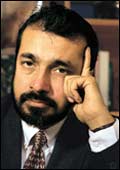|
Not
too long ago, people who called JWT India CEO Mike Khanna on his
mobile phone would get either his chauffeur or secretary. Not any
more; these days, the 63-year-old Khanna totes his phone around.
Attribute it to the inexorable march of technology. Or attribute
it to the times. The agency Khanna has headed for the past 18 years,
the country's largest, the Rs 1,589-crore J. Walter Thompson India
(formerly Hindustan Thompson Associates) is going through what may
well be the most troubled phase of its 79-year-old existence and
there's no telling what news, good or bad, the next call will bring.
Circa 2003, the behemoth's continued dominance
over the Rs 8,600-crore advertising market is in threat, the logical
culmination of signs that surfaced, one at a time and rather infrequently
at that in the late 1990s, and then rapidly accelerated in 2001.
A sampling from the past 14 months: in December 2001, Sunil Gupta,
heir apparent to Khanna leaves in circumstances far from pleasant;
then, in February 2002, O&M replaces JWT India as the preferred
agency of advertisers in AgenyTrack, research firm ORG-MARG's respected
advertising industry monitor; through the year, the agency's efforts
to find a replacement for Ivan Arthur as the national creative head
fail; and in May 2002, three more senior-than-senior execs leave.
What, Me Worry?
Creative mediocrity is JWT India's
public enemy #1. |
 |
 |
| A typical JWT commercial: Missing
the zing |
O&m's Piyush Pandey, McCann's
Prasoon Joshi, and Lowe's R. Balakrishnan (aka Balki) get more
press than their respective CEOs. JWT's... er, well India's
#1 agency doesn't have a creative head. The last man to hold
that post was Ivan Arthur who retired in August 2002, at the
ripe old age of 60. The grapevine had it that Deepa Kakkar,
Vice President and Executive Creative Director at the Mumbai
office was being groomed for the post, but the lady quit in
July 2002.
So, for well nigh seven months, JWT India has gone on about
its business without a creative head, making do with Peter
Hughes, JWT's Asia-Pacific creative head based out of Bangkok
whose services it enjoys for 15 days every month. And so,
even as names such as MTV's Cyrus Oshidar do the rounds, the
monolith continues its quest for someone who will be able
to fit into the strategy-planning led JWT way, yet help the
agency make that creative lead that has eluded it thus far.
Still, JWT's very success makes this search difficult. "A
successful system like JWT India is difficult to change,"
says Piyush Pandey, President and National Creative Director,
O&M, the agency that has usurped the creative leadership
of India's very own ulcer gulch. "What it needs is a
strong creative person who can battle with the system and
bring in discontinuity." And while JWT India has gone
on producing brand-driven formulatic creative work, its peers
have forged ahead: the agency did not win a single Gold Abby
(Bombay Ad Club) award in 2002; nor did it achieve anything
of note in global advertising shows. Sooner than later, this
culture of creative middle-of-the-roadness could manifest
itself in the work the agency does for some of its biggest
clients. That would hurt.
|
JWT's billings do not reflect any of this: with
billings of Rs 1,589 crore for 2001 (2002's figures are yet to be
tabulated by the notoriously cagey-with-numbers industry), it stands
head and shoulders above rivals such as Lowe India or O&M Advertising.
No major client has taken its account away from the agency although
there is every chance that HLL may shift its Close Up brand to another
agency. And JWT has gained some Rs 100 crore of new business from
20 new clients in 2002. Unbreakable, did you say? Yes, but for how
long?
Always A Middle-Of-The-Roader
With the suits calling the shots, creativity
has never been a priority for JWT. Not too long ago, says a former
employee, the executive committee would spend almost all its time
discussing finances. Any calls for building or nurturing creative
talent-and there were some claims the man-were rejected out of hand.
Things are different today. "Yes, we lag behind in creative
leadership," admits Khanna, "but we are looking for a
fighter there."
As long as it was successful, the strategy
driven approach worked for JWT. If it wasn't broke it didn't need
to be fixed, went the reasoning within the agency. The result? Functional
campaign followed functional campaign. Some of the agency's advertising
didn't work spectacularly well; nor was it a complete failure. And
so JWT plodded on, a strategic and marketing middle-of-the-roader,
but a creative laggard. "JWT mirrors client hierarchies at
every level," explains Ashutosh Khanna, senior Vice President
and Head, Delhi, Grey Worldwide. "So much so that a Pepsi thinks
like a JWT-that's a recipe for safe, strategic work, but not breakthrough
advertising."
JWT also suffered by comparison. O&M went
into creative overdrive in the early 1990s, and McCann and Lowe
by the end of the decade. By then no one was under any illusions
about the agency's creative abilities-critical to retain existing
clients, attract new ones, and develop creative talent. "JWT
is an account management driven agency," puts Samir Datar a
former Thompsonite and now Client Services Director at Cheil Communications.
"You won't find their creative guys being named when the honours
are being called out."
Khanna's anointed successor Kamal Oberoi, an
agency insider, hopes to change that. "We want to correct whatever
perception there is of us not being creatively driven," he
says. "We are making a sustained effort to push our creative
people out for the world to see." Still, that won't mean the
suits will curl up and go to sleep. "Our genes won't change,"
says the man who takes over from Khanna in April 2003 (the latter
steps back into a more mentoring sort of role apart from remaining
an Area Director for JWT).
Business As Usual...
...but that could change if the
company loses Hindustan Lever's Rs 60-crore Close Up account. |
 |
| A Close Up account: The smiles
are still there |
Although the first signs that
JWT India could lose its thought-leadership in the advertising
industry appeared as early as the 1990s, but it wasn't until
early 2002 that Ogilvy & Mather replaced the agency as
Indian marketers' #1 choice in ORG-MARG's AgencyTrack. "Any
advertising agency's product is its creative (output),"
says a senior manager who quit the advertising agency last
year, "and by 1997-98, JWT had already become a dirty
word with clients."
Still, AgencyTrack or not, and dirty word or not, JWT coasted
on, its business unaffected and its billings on steady-state
growth mode. The inability to bag awards didn't bother the
agency. Nor did the fact that it was slowly losing its lustre
as an employer of choice for young creative talent.
All that was fine in the heady days of 30 per cent growth,
but as markets started decelerating, clients started wondering
why their advertising wasn't as inspired as the competiton's.
It was functional and it was not terribly off the mark, but
it lacked the zing. That was little reason to shift accounts,
though, at least, not for the multinational corporations that
believed in international alignments with advertising agencies-close
to 60 per cent of JWT's business comes from such accounts.
Yet, there's only so much a client can take. The Rs 60-crore
Close Up account is up for review and the buzz is that HLL
may consider either O&M or Contract in JWT's stead. One
swallow doesn't a summer make, or does it?
|
Until now, many of these pronouncements have
remained mere words. A frantic several-months-and-counting hunt
for a "fighter who can serve as creative head" has proved
futile. Strangely, no one seems to want the top creative honcho's
job in India's #1 agency. "The bureaucracy at JWT is so strong
that I would have been unable to change much in the way of how it
approaches the creative function," says the creative head of
one of India's top agencies who was offered the job.
"We want to give supreme authority to
the creative head," rues Khanna. "But no one is willing
to take on the responsibility." And so, Khanna and Oberoi are
breaking boundaries in JWT, striving to create a non-bureaucratic
performance oriented culture. Demographically, JWT seems to be on
the right track. Khanna is 63. His replacement, Oberoi is 47. And
the head of JWT's Mumbai branch is the dapper 38-year old Tarun
Rai. None of that will help if the agency doesn't find a creative
head fast (An announcement was imminent as this magazine went to
press). "Look around at any agency turnaround,"says Sandeep
Vij, President, Optimum Media Solutions, the media arm of Mudra
Communications. "The story always revolves around a firebrand
creative head." Vij is right: it was Piyush Pandey for O&M,
Balki for Lowe, and Prasoon Joshi for McCann. Who will it be for
JWT?
Looking For An Alternative Solution
JWT's cause hasn't been helped by the profile
of clients it handles. Its growth is largely a function of international
realignments (Reckitt Benckiser shifts to JWT Worldwide and the
Indian arm benefits from the move). In JWT India's case, 60 per
cent of its business comes courtesy international alignments. In
an effort to achieve breakthrough growth, Khanna says the agency
is looking for "non-aligned businesses", much like Hindustan
Petroleum Corporation Limited and Godrej Appliances both of which
it signed on last year. He is also considering acquisitions. "We
are looking at specialised agencies that have business of at least
Rs 50 crore." All that will help, as will JWT's efforts to
grow allied businesses such as direct marketing. ThompsonConnect,
for instance is building Econnect, a back-end for all of its parent's
direct marketing data, the sort of it-enabled services business
for which India is renowned. "Worldwide," says Khanna,
in a rare philosophical moment for a man who is very much a business-minded
advertising pro, "clients are losing respect for advertising."
''India may go the same way if we don't pull ourselves (out of the
rut)." That, JWT India may be able to admit its competitors.
"Yes, JWT faces several challenges," says Sorab Mistry,
Chairman & CEO, McCann Erickson India, an agency whose star
is clearly on the ascendant. "But now that it has recognised
the challenges and is addressing them, it should be able to overcome
them." If only it were as easy.
It's All Over Now
For a while, it looked like JWT's
succession saga would spiral out of control. Things look better
now. |
 |
 |
| Sunil Gupta (L) and Kamal
Oberoi: The once and future king |
If JWT India has been in the
news for the past couple of years it hasn't been because of
big account wins or awards. Instead, the agency has made the
headlines over a messy succession issue. Heir apparent Sunil
Gupta left in December 2001, under circumstances that were
far from ideal. A spate of senior-exec exits followed: Vice
President and Executive Creative Director Deepa Kakkar in
July 2002, and Planning Director Bindu Sethi, Client Services
Director Jishnu Sen, and Commercial Director Ajit Kohli, all
in May 2002.
The advertising fraternity believes the issue is far from
resolved. One camp says Mike Khanna will be succeeded by Ambar
Brahmachari, now head of JWT Japan, while another says WPP
Head Martin Sorrel will identify the successor. Khanna insists
that all succession issues have been resolved. "Kamal
(Oberoi) will take over from me in April 2003," he says.
Still, protracted succession planning and the fact that the
agency is now looking for an outsider to take over as creative
head (just not on in India's very own university of advertising)
signal that things are definitely amiss at JWT India.
|
|

